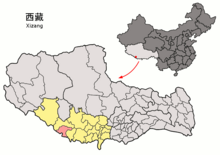Stele for emissaries of the Tang Dynasty to India

The stele for ambassadors of the Tang Dynasty to India or rock inscription for the delegation of the Tang Dynasty to Tianzhu (India) etc. ( Chinese 大唐 天竺 使出 铭 , Pinyin Dà Táng Tiānzhú shǐ chū míng , English Records of the Great Tang Mission to India / Rock Inscription on a Tang Mission to India / etc. ) from the year 658 of the Tang Dynasty is located in Gyirong County , Xigazê , of the Tibet Autonomous Region at an altitude of 4,130 m. The Chinese envoy Wang Xuance 王玄 策 had chosen the Tibet-Nepal route (i.e. the eastern route) for his third trip to India, which led past the inscription. The local population calls them (Chin.) 阿瓦 呷 英 摩崖 题 铭 (Pinyin: Awaxiaying moya timing). It is an inscription with over 300 Chinese characters, it is overwritten with the seven Chinese characters mentioned in the title. The inscription has been badly damaged by the weather over the years and many characters are unclear. It is the oldest monument in Tibet with Chinese characters. The inscription is of great importance for the relations of the Tang Dynasty with the Tubo Dynasty (Tibet) and the Sino-foreign relations of the time.
The rock inscription was first discovered in June 1990 in Gyirong County . It dates back to 658, the time of the Gaozong Emperor of the Tang Dynasty , i. H. from the 3rd year of the Xianqing era (" 大 唐显庆 三年 ").
Since 2001 it has been on the list of monuments of the People's Republic of China (5-408) together with two other monuments under one number .
literature
- Sen, Tansen: In Search of Longevity and Good Karma: Chinese Diplomatic Missions to Middle India in the Seventh Century. In: Journal of World History Volume 12, Number 1, Spring 2001, pp. 1–28
Web links
- New Archaeological Findings in Tibet (English)
- A Study of the "Inscription on the Stone Stele of the Emissary to Hindu from the Great Tang" (Chinese)
- A Second Probe into the Relative problems in "Da Tang Tian Zhu Shi Chu Ming" (Inscription about the Great Tang Envoys to Hindu) (Chinese)
Individual evidence
- ↑ german.china.org.cn (accessed on July 21, 2009)
- ↑ news.sina.com (accessed July 21, 2009)
Coordinates: 28 ° 53 ′ 0 ″ N , 85 ° 19 ′ 0 ″ E